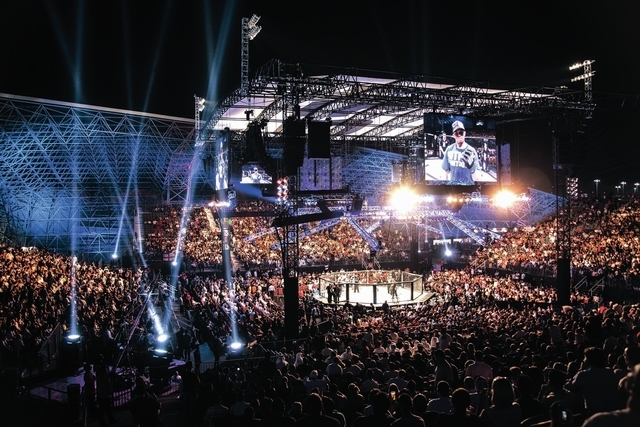Export product: UFC dispatching fight shows to global venues

With Ultimate Fighting Championship poised for rapid international expansion in 2014, the Las Vegas-based mixed martial arts fight organization faces one major challenge — exporting its signature high-energy fight show production to venues around the world.
Zuffa-owned UFC is staging 26 fight shows outside the U.S. in 2014 — a big increase over the 16 international UFC events held in 2013. The 16 UFC fight shows on foreign soil last year included six in Brazil, four in Canada, three in Europe/Africa/Middle East and two in Asia. The other one was in Australia.
In 2014, UFC’s international fight show portfolio will include adding six local fight shows each in Asia and Europe. In mid-September alone, there will be four UFC international fight shows in Brazil, Europe, Asia and Canada during a two-week span.
The goal is for UFC’s international offices around the world to eventually become self-sufficient in staging global fights that meet UFC’s lofty production standards of high-energy video, music, lights and audio.
But like any U.S.-based company producing a product overseas, UFC will keep a close and watchful eye on quality control of the foreign production from the U.S. headquarters in Las Vegas.
UFC is ramping up fight shows in worldwide cities so that MMA fans in those regions around the world can watch events in prime time. For fans in the U.S. interested in following the foreign fight shows, UFC has rolled out a new digital “Fight Pass” monthly subscription service that costs $9.99 a month.
To assure the international fight show productions meet UFC standards, the Las Vegas headquarters is sending staffers with fight event operations, regulatory, technical and production experience to work with UFC international offices and locally hired production crews and freelancers, said Craig Borsari, UFC executive vice president of operations and production.
“It’s a challenge. The goal is to put on a UFC event in an international (location) that looks, sounds and feels like those in the United States, but will have a localized feel to it so that it’s relevant and speaks to the local audience,” Borsari said.
“We know what works here and we think the high-energy experience has a global appeal. We do not want to strip that down and change anything in terms of the energy,” he said. “We want the signature look and feel of the UFC, but localize it to fans in that market.”
That means Borsari has to walk a fine line of re-creating UFC’s fight show atmosphere while being sensitive to the local customs, language, culture and traditions in the local market of any particular international setting.
For example, Octagon girls at the UFC fight shows in the U.S. and Brazil bare lots of skin in bikini outfits, but their wardrobe is more conservative for fight events in China.
“It’s a daily or nightly conversation with headquarters making sure the show build-out meets UFC standards with meeting local market nuances, like having local voices on promos and element pieces,” Borsari said.
UFC officials at the Las Vegas home base will work with their managers in the field across the world for everything from finding local on-air TV talent to companies that own TV equipment that are compatible with UFC’s broadcast system.
They are in close contact with senior staffers in UFC foreign offices in Beijing, London, Sao Paulo, Singapore, Toronto.
“(UFC’s) Vegas (office) will be dictating how the show is built out, approving all elements and format of the show. We will find local production crews and work with them and enlisting freelancers like camera operators,” Borsari said.
In a recent UFC international fight show in Singapore, about 60-70 freelance workers were hired for the job on production at the 5,000-seat arena.
In the U.S. at the MGM arenas where UFC stages its fight shows, for example, UFC will use about 100 staffers, Borsari said.
Exporting the UFC spectacle template to Singapore — or any foreign venue — means retaining the high-powered lighting grid, the music and video elements between fights and making sure all language is localized.
“The videos will be catered to the market,” Borsari said. UFC is high energy and the variations of what that energy will be is customized to Brazil, Japan or wherever the event is. There is not one piece or the element that runs in English. In Brazil, everything is in Portuguese. In Japan, everything is in Japanese.”
Business writer Alan Snel can be contacted at asnel@reviewjournal.com or 702-387-5273. Follow @BicycleManSnel on Twitter.